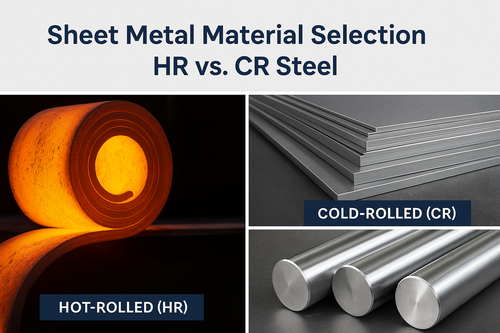Sheet Metal Material Selection: HR vs. CR Steel
Choosing the right material is one of the first and most critical decisions in sheet metal die design. The material’s mechanical properties, surface finish, and manufacturing history directly impact forming quality, tool wear, and final product performance. In this article, we compare the two most common sheet metal types—Hot-Rolled (HR) and Cold-Rolled (CR) steel—to help engineers and designers select the best fit for their application.
What Is Hot-Rolled (HR) Steel?
Hot-rolled steel is produced by rolling steel at high temperatures (above 900°C). The steel is more malleable and easier to shape during this process, making it suitable for parts where precise dimensions are not critical.
Key Features:
Processed at high temperatures
Scaled, rough surface finish
Less dimensional accuracy
More ductile, easier to form
Lower cost
Common Uses:
Automotive chassis components
Welded tubes and structural parts
Frames and agricultural equipment
What Is Cold-Rolled (CR) Steel?
Cold-rolled steel is processed further at room temperature after being hot-rolled. This additional processing improves surface finish and dimensional accuracy but increases cost and hardness.
Key Features:
Processed at room temperature
Smooth, clean surface finish
Tighter dimensional tolerance
Increased strength and hardness
Higher cost
Common Uses:
Appliance panels
Furniture
Precision sheet metal parts
HR vs. CR Steel: Side-by-Side Comparison
Property | Hot-Rolled Steel (HR) | Cold-Rolled Steel (CR) |
|---|---|---|
| Processing Temp | > 900°C | Room temperature |
| Surface Finish | Rough, scaly | Smooth, polished |
| Dimensional Accuracy | Moderate to low | High |
| Strength | Lower | Higher (strain hardened) |
| Ductility | Higher | Lower |
| Cost | Lower | Higher |
| Formability | Good | Moderate (springback risk) |
When to Use HR vs. CR
Application Type | Recommended Material |
| Structural frames | Hot-Rolled |
| Precision parts | Cold-Rolled |
| Painted/enamel surfaces | Cold-Rolled |
| Welded components | Hot-Rolled |
| Deep drawn parts | Hot-Rolled or special CR |
Special Considerations
Springback in CR steel: Designers should account for increased springback due to higher yield strength.
Tool wear: CR steel, being harder, wears out cutting tools and punches faster.
Lubrication: CR steel surfaces require better lubrication to avoid galling.
Appearance: CR is preferable where aesthetics matter (exposed surfaces).
Conclusion
Both hot-rolled and cold-rolled steels are essential in sheet metal forming, each serving distinct roles depending on accuracy, strength, cost, and surface finish requirements. A clear understanding of the differences helps engineers choose the right material, minimize costs, and ensure product performance.
